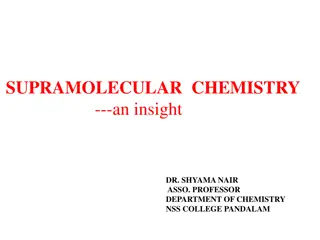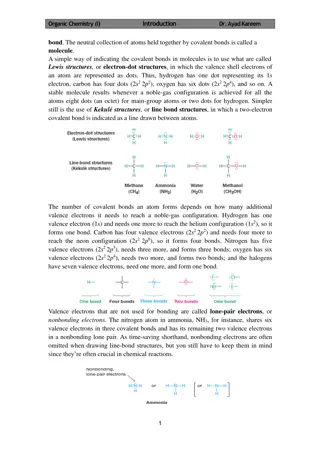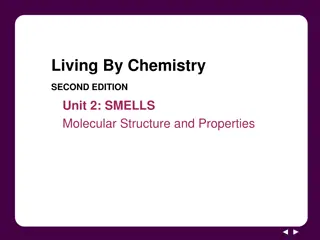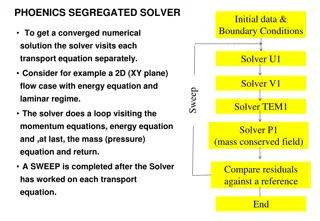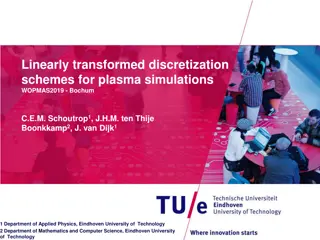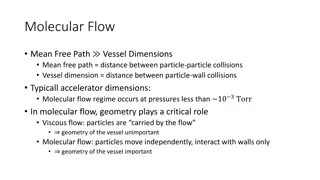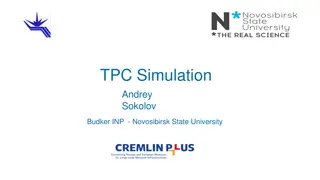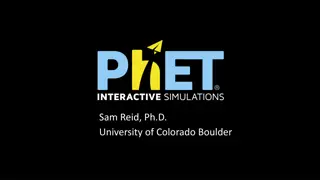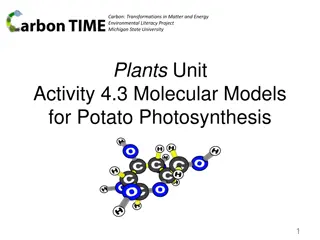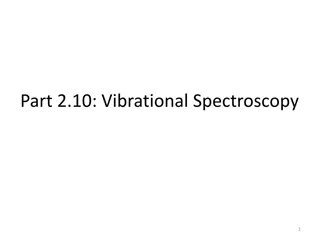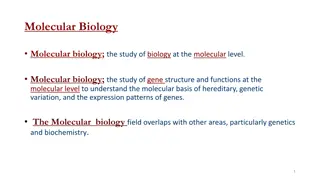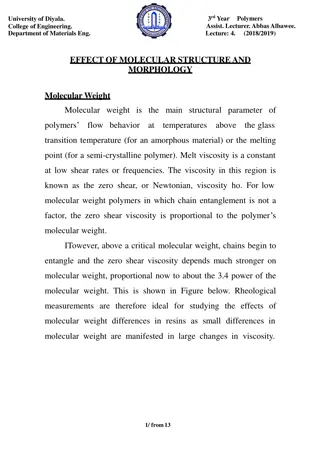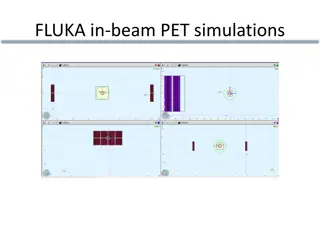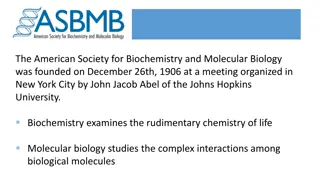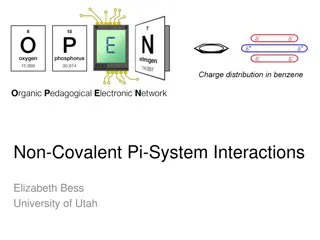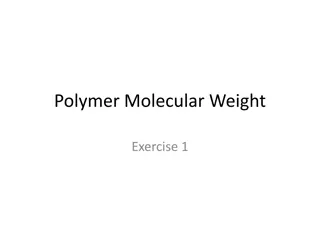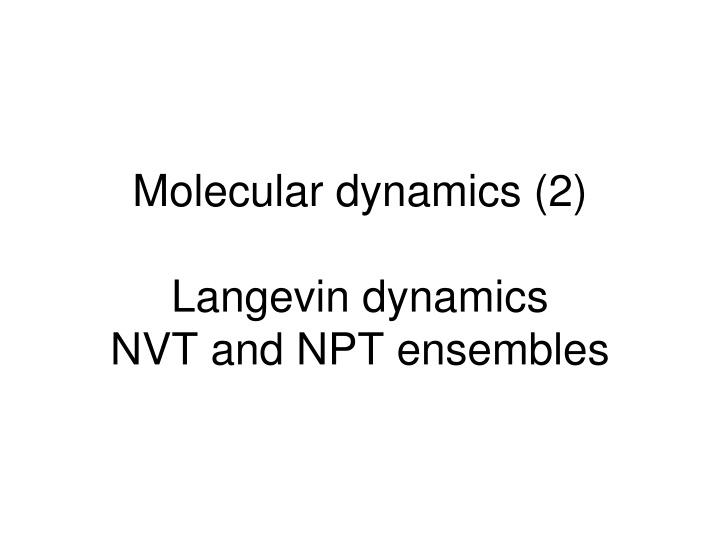
Molecular Dynamics: Langevin Dynamics, Brownian Dynamics, and Andersen Thermostat
Explore the world of molecular dynamics through Langevin simulations, Brownian dynamics, and the use of an Andersen thermostat. Learn about NVT and NPT ensembles, Gaussian distributions, stochastic forces, and more in this comprehensive guide to simulating molecular systems.
Download Presentation

Please find below an Image/Link to download the presentation.
The content on the website is provided AS IS for your information and personal use only. It may not be sold, licensed, or shared on other websites without obtaining consent from the author. If you encounter any issues during the download, it is possible that the publisher has removed the file from their server.
You are allowed to download the files provided on this website for personal or commercial use, subject to the condition that they are used lawfully. All files are the property of their respective owners.
The content on the website is provided AS IS for your information and personal use only. It may not be sold, licensed, or shared on other websites without obtaining consent from the author.
E N D
Presentation Transcript
Molecular dynamics (2) Langevin dynamics NVT and NPT ensembles
Langevin (stochastic) dynamics 2 d x 2 dx V = + rand i i m f i i i dt 6 x ) dt i = + ( r r Stokes law i i w w i the friction coefficient of the ith atom ri, rw the radii of the ith atom and of water, respectively w the viscosity of water. 2 RT ( ) t ( ) = + = rand i lim lim ) 1 , 0 ( f W t t N i i t 0 0 t t ( ) t ( ) ( ) t + = 2 Wiener process W W t t RT i j i ij
The average kinetic energy of Langevin MD simulation corresponds to absolute temperature T and the velocities obey the proper Gaussian distribution with zero mean and RT/m variance. 1 3 N 2 3 = N 2 = = v E m RT k i i 2 1 i We can also define the momentary temperature T(t) 2 1 3 N ( ) t ( ) t ( ) t = i 2 = = v T E m k i i 3 3 NR NR 1
Integration of the stochastic equations of motion (velocity-Verlet integrator) t i ( ) + = + 2 m r r v ( ) ( ) t t t t t e i i i i t t i ( ( ) t ) ( ) + + 4 m F r W t t e i i i 2 m i t i ( ) ( + = m v v ( ) t t t e i i i t t W t i i ( ) t ) ( ( ) ) ( ) + + + + 2 2 m m F r F r i t t e t e i i i i 2 m m i i Ricci and Ciccotti, Mol. Rhys., 2003, 101, 1927-1931. Ciccotti and Kalibaeva, Phil. Trans. R. Soc. Lond. A, 2004, 362, 1583-1594.
When t and the friction coefficient are small, the exponential terms can be expanded into the Taylor series and the integrator becomes velocity-Verlet integrator with friction and stochastic forces ( ) + = + r r v ( ) ( ) t t t t t i i i v t ( ) ( ( ) t ) ( ) + + F r W ( ) t t t t i i i i 2 m + ( i = v v ( ) t t t ( ) m i i W t t ( ) t ) ( ( ) ) + + + + F r F r v i 2 ( ) t t t i i i i 2 2 m i i
Brownian dynamics Ignore the inertia term; assume that the motion results from the equilibrium between the potential and fritction+stochastic forces. dx E = + rand i f i i dt x i Advantage: first-order instead of second-order ODE. Disadvantages: constraints must be imposed on bonds; energy often grows uncontrollably.
Andersen thermostat 1.Perform a regular integration step in microcanonical mode. 2.Select a number of particles, n, to undergo collision with the thermal bath. 3.Replace the velocities of these particles with those drawn from the Maxwell-Boltzmann distribution corresponding to the bath temperature T0.
Berendsen thermostat: derivation from Langevin equations 1 dE N N ( ) ( ) t = i = i 2 2 = + v v k lim m t t m i i i i 02 dt t t 1 1 Therefore: v dE d N ( ) t = = = v k i m i i dt N = dt 1 i 3 N 2 ( ) t + = v F 2 RT E 0 i i k 1 i N ( ) t ( ) = + v F 3 NR T T 0 i i 1 i
T = + v F v 0 1 m m i i i i i T v v i i 2 T t ( ) 1 = + + = 0 1 1 ... 2 T T T T t = + 0 1 1 T T
Berendsen thermostat T t + v v 0 1 1 ( ) t i i T 1 ( ) t 2 E 3 n ( ) t ( ) t = i 2 = = v k T m i i 3 NR NR 1 coupling parameter = 1 : velocities reset to maintain the desired temperature t time step Ek kinetic energy Berendsen et al., J. Chern. Phys., 1984, 81(8) 3684-3690 : microcanonical run
Pressure control (Berendsen barostat) 1 t ( ( ) t ) 3 + 1 L L p p 0 1 1 n n ( ) t ( ) t ( ) t ( ) t = i = i j 2 = + F r v p m ij ij i i 3 2 V + 1 1 L the length of the system (e.g., box sizes) isothermal compressibility coefficient coupling parameter t time step p0 external pressure
Extended Lagrangian method to control temperature and pressure Lagrange formulation of molecular dynamics 1 3 N ( ) = i = = 2 , , , L T V m q V q q q 1 2 3 i i N 2 1 A physical trajectory minimizes L (minimum action principle). This leads to Euler equations known from functional analysis: d L L V = = = m q F i i iq dt q q q i i i
Nose Hamiltonian and Nose Lagrangian 2 p 2 ( ) r p 2 N = 1 i = + + + N s ln H V gRT s Nose 2 2 m s Q + 1 i i ( ) r Q 2 N = 2 = 2 2 N r ln L m s V s gRT s Nose i i 2 1 i = = 2 p r L m s r i i i i L = = p Qs s s s the coordinate that corresponds to the coupling with the thermostat Q the mass of the thermostat g the number of the degrees of freedom (=3N)
Equations of motion (Nose-Hoover scheme) p = r i i m ( ) p i = 1 2 N p r p V r i i i N = s i = gRT ln 2 Q m 1 i i s d = = s dt
Velocity-Verlet algorithm ( ) m i f t t ( ) ( ) t ( ) t ( ) ( ) v t + = + + i r t t r v t t i i i 2 ( ) m i + f t ( ) ( v ) + + i t t t t i t ( ) ( ) t + = + v t t v ( ) m i f t i i ( ) ( ) v t 2 i t i 2 t 3 = N ( ) ( ) t ( ) t ( ) t + = + + 2 ln ln s t t s t m v gT i i 2 Q 1 i 3 = N ( ) + 2 m v t t gT i i t ( ) ( ) t + = + t t 1 i 3 = N 2 Q ( ) t + 2 m v gT i i 1 i
The NH thermostat has ergodicity problem velocity position position position Nose-Hoover thermostat Microcanonical Andersen thermostat Test of the NH thermostat with a one-dimensional harmonic oscillator
Nose-Hoover chains p = r i i m ( ) = i 1 i = 1 N p r p V r 1 i i i 2 p g N i = 1 1 2 2 Q m 1 i ( ) 1 = 2 Q RT + 1 1 1 j j j j j Q j 1 ( ) = 2 Q RT 1 1 M j M Q M 2 2 p Q ( ) r N M M = i = j = j j 2 j i = + + + + N H V gRTs RTs 1 NHC j 2 m 1 1 2 i
Improvement of ergodicity for the NH chains thermostat Test with a one-dimensional harmonic oscillator
Relative extended energy errors for the 108-particle LJ fluid Kleinerman et al., J. Chem. Phys., 2008, 128, 245103
Performance of Nose-Hoover thermostat for the Lennard-Jones fluid Kleinerman et al., J. Chem. Phys., 2008, 128, 245103
Performance various termostat on decaalanine chain Kleinerman et al., J. Chem. Phys., 2008, 128, 245103
Extended system for pressure control (Andersen barostat) p 1 V = + r r i i i 3 m V i 1 V = p F p i i i 3 V 1 ( ) t V = P P 0 W W the mass corresponding to the barostat (can be interpreted as the mass of the piston ) V is the volume of the system
Isothermal-isobaric ensemble p p p p d = + = + r r p F p p i , 1 i i i i i i m W g W W i 2 p p dVp d N ( ) t = i i = = + , V p dV P P p 0 W g m Q 1 i 2 p p 2 p N ( ) = i i = = + + , 1 p g RT Q m W 1 i d is the dimension of the system (usually 3) g is the number of degrees of freedom W the mass corresponding to the barostat Q is the mass corresponding to the thermostat Martyna, Tobias, and Klein, J. Chem. Phys., 1994, 101(5), 4177-4189
Martyna-Tobias-Klein NPT algorithm: tests with model systems Model 1-dimensional system: position distribution Model 3-dimensional system: volume distribution Martyna, Tobias, and Klein, J. Chem. Phys., 1994, 101(5), 4177-4189
The Langevin piston method (stochastic) p 1 V = + r r i i i 3 m V i 1 V = p F p i i i 3 V 1 ( ) t ( ) t V = + p p V f 0 rand W RT 2 ( ) t ( ) ( ) t + = f f t t rand rand W Feller, Zhang, Pastor, and Brooks, J. Chem. Phys., 1994, 103(11), 4613-4621
W=5 W=25 W=225 Extended Hamiltonian method =0 ps-1 =20 ps-1 =50 s-1 Langevin piston method (W=25) p=1 ps p=5 ps Berendsen barostat Feller, Zhang, Pastor, and Brooks, J. Chem. Phys., 1994, 103(11), 4613-4621


